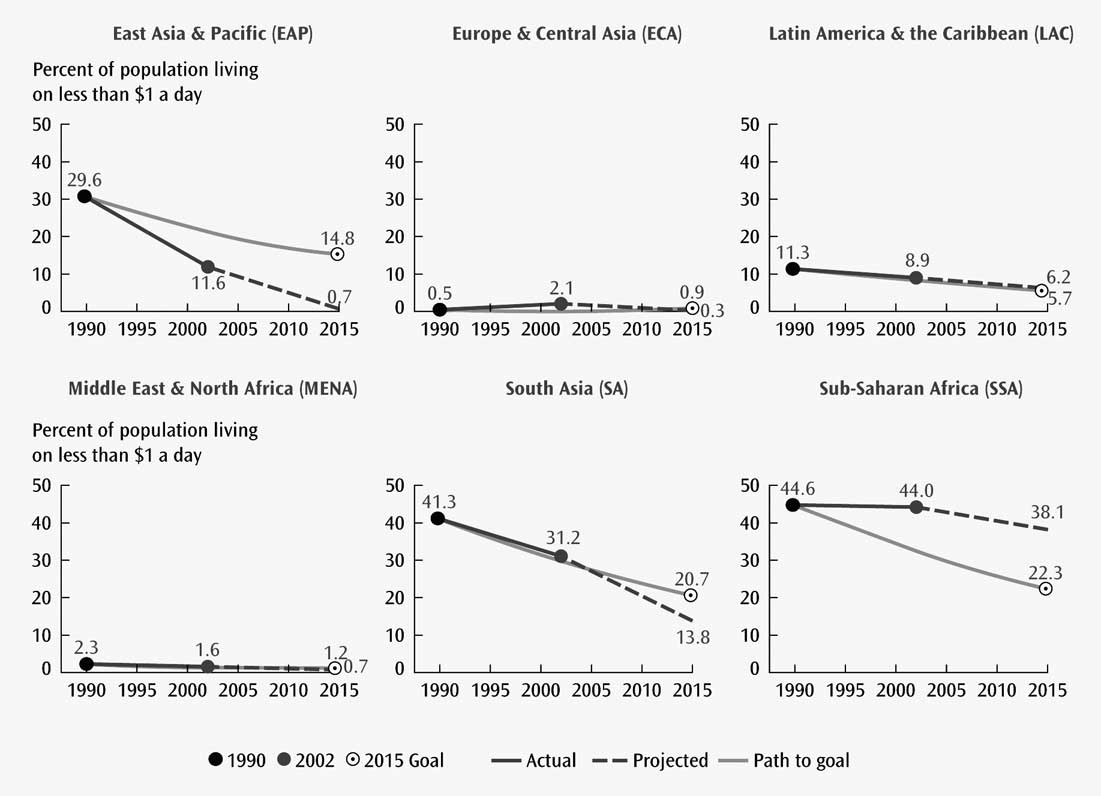
| Previous | Return to table of contents | Search Reports | Next |
| « Back to weltagrarbericht.de | ||
Context, Conceptual Framework and Sustainability Indicators | 15

Figure 1-8. Poverty by region, 1990-2002, and forecasts to 2015. Source: Global Monitoring Report, 2006.
|
to significantly add to the health burden, especially of infants (Gong et al., 2004), and cause widespread problems with basic foodstuffs (Strosnider et al., 2006). This has become an issue for formal AKST, as is water quality, which is linked to improving rural livelihoods, human health and nutrition and to the covering of protein requirements, particularly in the case of children. Human health is also linked with animal health: numerous examples of zoonoses are reported, including avian influenza, hoof and mouth disease, and brucellosis. In 50% of cases undernutrition is due to poor sanitation and diseases (Prüss-Üstün and Corvalán, 2006). This fundamental issue is reflected throughout the AKST context and emphasizes traditional food safety, including hygiene issues related to animal husbandry and phytosanitary protection, food storage in homes and food handling in developing countries. Furthermore, in developing countries such phytosanitary issues as Claviceps purpurea or ergotism, (which are no longer problems in the North because of highly protected industrial food production), are significantly adding to the health burden, especially of infants (Gong et al., 2004) and cause hygienic problems amongst billions with basic foodstuffs (Strosnider et al., 2006). Poverty and undernourishment are intimately linked. The MDG targets for 2015 are expected to be met by most regions except for sub-Saharan Africa in particular and South Asia (see Figure 1-9). A direct consequence of poverty is undernourishment, which is an issue not only for the urban poor and for landless persons, but particularly for the underprivileged such as women and children. Undernourishment also affects rural people producing agricultural goods and services on farms |
that are too small, not productive enough, or too degraded to produce sufficient outputs for a decent living. Good nutrition has thus much to contribute to poverty reduction. It is intrinsic to the accumulation of human capital, since sound nutrition provides the basis of good physical and mental health, and thus of intellectual and social development and a productive life. If global poverty is to be reduced, agricultural development will have to pay particular attention to the problems faced by deprived small-scale producers and their families. Science and technology are expected to contribute to the achievement of this goal. Promotion of socially equitable and environmentally and economically sustainable development. Sustainable development is about meeting current needs without compromising the ability of future generations to meet their own needs. Within this context, sustainability is envisaged within three key dimensions: social, environmental and economic, all three of which have direct and indirect linkages to agriculture. In the context of the IAASTD, the term "agriculture" encompasses crop cultivation, livestock production, forestry and fishery. This broader definition provides future opportunities for maximizing synergies in achieving development and sustainability goals. It serves the primary goal of providing sufficient and nutritious food for humankind, in the present and in the future. It is indisputable that agriculture as a sector cannot meet this goal on its own. Agriculture, however, fulfills a series of additional goals besides food production. Last but by no means least, agriculture ensures the delivery of a range of ecosystem services. In view of a globally sustainable form of development, the importance |
| Previous | Return to table of contents | Search Reports | Next |
| « Back to weltagrarbericht.de | ||